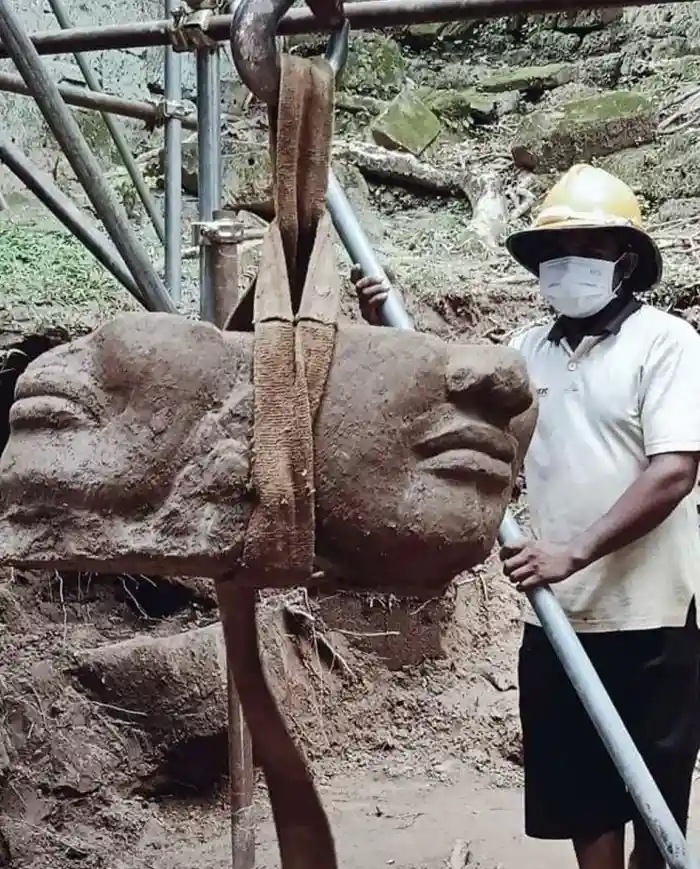

The restoration project of Takav Gate was started in May (All images courtesy: APSARA National Authority and Twitter/@PeacePalaceKH)
<p>
<strong>A four-faced head of a Deva (guardian god) statue has been found in the ground near the northeast corner of the Takav Gate, one of the five entry points to the ancient walled city of Angkor Thom, said to be the last and most enduring capital of the Khmer empire just to the north of Angkor Wat in present-day Cambodia.</strong></p>
<p>
The gate is located west of Bayon Temple which stands at the centre of Angkor Thom and is known for its most distinctive feature – around 200 stone faces which jut out from the upper terrace and cluster around its central peak.</p>
<p>
<img alt="Cambodia Angkor Wat" src="https://www.indianarrative.com/upload/news/angkor_wat.webp" style="width: 100%; height: 100%;" /><br />
<br />
The head of the newly-found statue which has &quot;two faces from the middle of the nose&quot; has been reassembled by a team of archaeologists and, with the assistance of the heritage police, kept on site for further restoration.<br />
<br />
The restoration project of Takav Gate was started in May by the APSARA National Authority (ANA) – which protects one of the largest archaeological sites in the world – and is expected to complete in 2023.</p>
<p>
<img alt="Angkor Wat" src="https://www.indianarrative.com/upload/news/angkor_wat_heritage.webp" style="width: 100%; height: 100%;" /><br />
<br />
&quot;For this Deva&#39;s head statue, the team had an assemble trial with the statue of Deva&#39;s shoulder that was found earlier. As a result, the head statue matched with the body,&quot; the authority revealed on Monday.<br />
<br />
ANA archaeologist Kim Sengpheakdey said that the restoration and strengthening the Takav Gate is focusing on restoring the statues of the elephants, the Devas and Asuras (the demons) built in the late 12th or early 13th century. The gate was made of sandstone and laterite with three four-faced Brahma above.<br />
<br />
&quot;Some of the challenges that the team encountered were that the elephants or other structures had broken into small pieces. They were difficult to reassemble and we needed some new stones to replace the missing ones,&quot; she said.</p>
<p>
<img alt="Angkor Wat Cambodia" src="https://www.indianarrative.com/upload/news/cambodia_angkor_wat.webp" style="width: 100%; height: 100%;" /><br />
<br />
In July, the authority had announced that during the first three weeks of the excavation work, some statues and artifacts have been found.</p>
<p>
It included six Asura heads, of which three were in good condition, while the other three were only half full, along with four Asura&#39;s bodies.</p>
<p>
For the three heads of the Devas found, two of them were in good condition, and the other one was only half a shoulder to the lips.</p>
<p>
<img alt="Angkor Wat" src="https://www.indianarrative.com/upload/news/cambodia_artefact.webp" style="width: 100%; height: 100%;" /></p>
<p>
It was the Mahayana Buddhist King Jayavarman VII (1181-1220), regarded as one of the most fascinating personality in Khmer history, who founded Angkor Thom and built temple-mountain Bayon, around which he developed the entire capital. The city measures nine square kilometers and homes major temples of the king.<br />
<br />
Following Jayavarman&#39;s death, it was modified and augmented by later Hindu and the ravada Buddhist kings in accordance with their own religious preferences.<br />
<br />
The Bayon Temple remains one of the more famous, popular and beautiful of the structures in the Angkor Wat Archeological Park, the largest religious monument in the world measuring 162.6 hectares.<br />
<br />
According to Cambodia&#39;s ministry of tourism, the Angkor Wat temple complex was originally constructed as a Hindu temple dedicated to the god Vishnu for the Khmer Empire, gradually transforming into a Buddhist temple towards the end of the 12th century.</p>
<p>
<img alt="Cambodia Tourism" src="https://www.indianarrative.com/upload/news/cambodia_tourism.webp" style="width: 100%; height: 100%;" /><br />
<br />
Between 1986 to 1993, at a time when peace was yet to be restored in Cambodia after the collapse of the Khmer Rouge regime, the Indian government – responding to an appeal by Phnom Penh – undertook the conservation of the Angkor Wat temple at a cost of US$ 4 million. &nbsp;<br />
<br />
In 1992, the Angkor monument was registered on the UNESCO World Heritage List as a monument of universal value for human being and, at the same time, also as a monument exposed to the crisis. In 2004, the Angkor site was taken off the World Heritage List in danger.</p>
<p>
<strong>Also Read: <a href="https://www.indianarrative.com/world-news/nearly-four-lakh-people-to-benefit-as-india-supplies-and-installs-hand-pumps-in-cambodia-117653.html">Nearly four lakh people to benefit as India supplies and installs 1500 hand pumps in Cambodia</a></strong></p>
Union Minister of Coal and Mines G Kishan Reddy on Tuesday held an inter-ministerial meeting…
India's largest automobile in-plant railway siding at Maruti Suzuki's Manesar facility started operation on Tuesday,…
Google on Tuesday unveiled its Safety Charter for India's AI-led transformation, at the "Safer with…
The human rights organisation of the Baloch National Movement (BNM), Paank, has published its most…
The Israel Defence Forces (IDF) on Tuesday claimed that it has killed Iran's senior-most military…
Amid escalating conflict between Iran and Israel, the Ministry of External Affairs (MEA) on Tuesday…